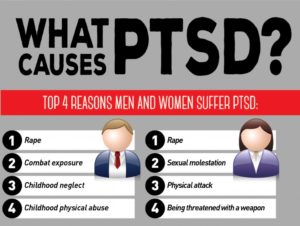EMDR for substance abuse treatment is an addiction treatment process that focuses on memory. Harmony Grove Recovery provides a variety of therapies including EMDR. Eye Movement Desensitization and Reprocessing (EMDR) Therapy is used for the treatment of post traumatic stress disorder (PTSD) and other disorders. EMDR is guided by the Adaptive Information Processing model. EMDR is provided during individual therapy to assist individuals to process and overcome traumatic life experiences and promote overall health. This therapy is extremely beneficial for individuals in recovery to build a solid recovery foundation and promote long term sobriety.
EMDR for Substance Abuse Rehabilitation Works Well for PTSD

EMDR is an ideal therapy for individuals working towards processing traumatic memories. This therapy can be completed in both short and long term treatment environments. Harmony Grove Recovery is a unique treatment facility who truly tailors treatment specific to the individual offering individual therapy of 1-2 hours per day up to six days a week. We understand most individuals have experienced unfortunate situations which are at times uncomfortable to speak about in a group setting which is why we value individual therapy specifically EMDR.
The Adaptive Information Processing model considers symptoms of PTSD and other disorders resulting from past disturbing experiences that continue to cause distress because the memory has not been properly processed. These unprocessed memories are understood to contain the thoughts, emotions, beliefs and physical sensations that occurred at the time of the event. When these memories are triggered these stored disturbing elements are experienced and cause the symptoms of PTSD and/or other disorders.
Unlike other therapies and treatments that focus on directly altering the thoughts, emotions, and responses resulting from the traumatic experiences, EMDR therapy focuses directly on the memory. It is intended to change the way the memory is stored in the brain, thus reducing and eliminating the problematic symptoms and allowing the individual to move forward in life and in their recovery.
How Does EMDR Work?
During EMDR therapy, the individual will be asked to focus on a specific event. Attention will be given to a negative image, belief, and body feeling related to this event. Then to a positive belief that would indicate the issue was resolved. While the individual is focusing on the negative event, the therapist begins sets of side-to-side eye movements, sounds, or taps. The individual is guided to notice what thoughts come to mind after each set. The individual may experience shifts in sight or changes in images, feelings, or beliefs surrounding the event. The sets of eye movements, sounds, or taps are repeated until the event becomes less disturbing.
A typical session at our drug rehabs Escondido, California facility lasts between 60-90 minutes. Many individuals have found this therapy to be very beneficial in their recovery and overall health. Each individual is provided with an initial session to determine if this therapy is appropriate and at what frequency. EMDR consists of 8 phases:
- initial history discovery and treatment planning
- preparation
- assessment
- desensitization
- installation
- body scan
- closure
- re-evaluation
This treatment is ideal for substance abuse treatment for it can be completed in a short amount of time or longer depending on the individuals treatment goals and length of desired stay. Complete treatment of the targets involves a three pronged protocol to alleviate the symptoms and address the complete clinical picture:
- Past memories
- Present disturbance
- Future actions
What is the Goal of EMDR for Substance Abuse Rehabilitation?

The ultimate goal of our drug rehabs Escondido, California centers EMDR therapy is to process completely the experiences that are causing problems, and to include new experiences that are needed to move forward and live a healthy happy life. Processing these negative experiences does not mean talking about them like other therapies but rather setting up a learned state that will allow experiences causing problems to be digested and stored appropriately in your brain. Meaning what is useful to you from an experience will be learned, and stored with appropriate emotions in your brain, allowing you positive guidance in the future. The negative beliefs, emotions, and body sensations will be discarded.
Phase 1: History and Treatment Planning
During the initial session the therapist takes a thorough history of the individual and develops a treatment plan. This process may continue throughout the course of treatment depending if new problems are revealed. This phase includes identifying specific problems, behaviors and symptoms stemming from that problem. The therapist will develop a treatment plan using the discussed information that identifies the specific targets on which to use EMDR:
- The negative events producing problems
- The present situations causing distress
- The needed skills and behaviors for the individual to learn for future well being
Phase 2: Preparation
During this phase the therapist will teach the individual some specific techniques so they are able to rapidly deal with any emotional disturbance that may arise. This phase is about establishing a relationship of trust between the therapist and the individual. The therapist will explain the theory of EMDR, how it is done, and what to expect during and after treatment. Lastly the therapist will teach the individual a variety of relaxation techniques for calming in the event the individual may experience any emotional distress during or after session.
Phase 3: Assessment
During this phase the individual will be prompted to access each target in a controlled manner so it can be effectively processed. The therapist identifies different parts of the target to be processed.
First the individual will select a specific mental picture from the target event which is identified during Phase One that best represents the memory. Then the individual chooses a statement which expresses a negative notion associated with that event. These negative beliefs are verbalizations of the disturbing g emotion. Statements include “ I am helpless,” “ I am unloveable,” “I am bad,” etc.
The individual then picks a positive self-statement to believe instead. Such as “ I am in control,” “I am lovable,” or I am good.”
Our drug rehabs Escondido, California therapist will ask the individual to estimate how true the positive belief feels using the 1 to 7 Validity of Cognition (VOC) scale. 1 equals completely false and 7 equals completely true. It’s important to understand this scale reflects how the individual “feels,”not “thinks.”
Also during this phase the individual identifies the negative emotion and physical sensation (tightness in the chest, cold hands) associated with the target. The individual rates the negative belief using the Subjective Units of Disturbance (SUD) scale. This scale rates feeling from 0 (no disturbance) to 10 (worst).
The goal of EMDR therapy at Harmony Grove Recovery is for SUD scores of disturbance to decrease while the VOC scores of positive belief increase. This will allow the individual to become more balanced and provide a solid recovery foundation for long term sobriety.
Phase 4: Desensitization
During this phase the individual will focus on disturbing emotions as they are measured by the SUDs rating. This phase deals with all of the individuals responses as the targeted event changes and its disturbing elements are processed.
The therapist leads the individual in sets of eye movements, sounds, or taps with appropriate shifts and changes of focus until the SUD levels are reduced to 0.
Phase 5: Installation
This phase is to concentrates on and increase the strength of the positive belief the individual is to replace with the original negative belief. The individuals positive cognition “I am lovable” will be strengthened and installed. How deeply the individual believes the positive cognition is then measured using the Validity of Cognition (VOC) scale. The goal is for the individual to accept fully the positive self-statement with a score of 7.
Phase 6: Body Scan
Once the positive cognition has been installed, the therapist will ask the individual to bring the original target event to mind and see if anything is still lingering. If so, these physical sensations are targeted for reprocessing.
Studies have shown that there is a physical response to unresolved thoughts. When a individual is negatively affected by trauma, information about the traumatic event is stored in body memory (motoric memory) and retains the negative emotions and physical sensations of the original event. When this is processed it can be moved to the narrative (or verbalized) memory and the body sensations and negative feelings disappear.
Phase 7: Closure
Closure occurs every session. This ensures the individual leaves each session feeling better than at the beginning.
If the processing is not able to be completed by end of session the therapist will assist the individual is using a variety of self-calming techniques in order to regain a sense of equilibrium. The individual is also briefed on what to expect between sessions, how to use a journal to record experiences, and what calming techniques could be used to self-soothe outside of sessions.
Phase 8: Re-evaluation
This opens every new session. This phase guides the therapist through the treatment plans that are needed to deal with the individuals problems. Although individuals may feel relief immediately with EMDR, it’s important to complete all 8 phases.
Harmony Grove Recovery drug rehabs Carlsbad provides this important therapy to all individuals interested in processing traumatic experiences. This therapy is only performed by qualified therapists with this specialized training to ensure proper procedure and lasting results.
